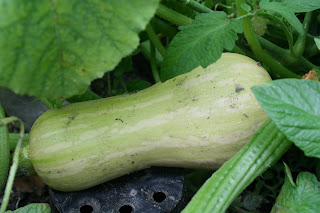This is a testament to being adventurous in the kitchen (and other places of course!). Inspired by the Cookbook a month blog I decided to challenge my prejudices and try Nigella Lawson's recipe that involves sultanas with courgettes (which I have only tried in carrot cake style cupcake). It has turned out to be yet another way to use up courgettes but this is worth it even when you don't have a glut as it's surprisingly delicious. The quantities are supposed to serve 4 but I found it was fine for two greedy people. I also reduced the parsley to 3 tablespoons and increased the garlic to 4 cloves (there is always a risk of vampires in South London and we need to be prepared). We also tossed in a couple of extra tablespoons of butter with the pasta at the end as we crave heart attack by fat later in life.
•3 tablespoons butter
•1 tablespoon olive oil
It has turned out to be yet another way to use up courgettes but this is worth it even when you don't have a glut as it's surprisingly delicious. The quantities are supposed to serve 4 but I found it was fine for two greedy people. I also reduced the parsley to 3 tablespoons and increased the garlic to 4 cloves (there is always a risk of vampires in South London and we need to be prepared). We also tossed in a couple of extra tablespoons of butter with the pasta at the end as we crave heart attack by fat later in life.
•3 tablespoons butter
•1 tablespoon olive oil
•675g courgettes (4 medium)
•4 cloves garlic, chopped
•salt
•3 tablespoons Marsala (keep it boozy!)
•1/3 cup sultanas (golden raisins)
•2 tablespoons pine nuts
•225g egg pappardelle
•5 tablespoons freshly grated Parmesan
•3 tbsp fresh parsley, chopped
Directions
Heat one tablespoon of butter and oil in a heavy-based saucepan, and cut the courgettes into very fine rounds before adding them to the pan. Chopped up the garlic and add in, season with salt. Cook over a low to medium heat for about 45 minutes, stirring every now and again.
At the same time, warm the Marsala, pour it over the sultanas and leave them to plump up for about 15 minutes (pop in the microwave for 30 seconds to speed things up). Once the courgettes are cooked, stir the sultanas and their juices into them. Taste for seasoning. Toast the pine nuts by cooking them in a dry frying pan until they turn a golden brown, and remove to a cold plate.
Cook the pasta according to package instructions, then drain and tip into a bowl, toss with the last two tablespoons of butter. Add the courgette mixture and fold and toss to combine. Sprinkle over the pine nuts, Parmesan and most of the chopped parsley and toss everything gently together again. Sprinkle with the remaining parsley and take to the table. Add even more Parmesan. YUM!
 Well Christmas is tomorrow and I went down to the plot to check on the brussel sprouts. They are looking healthy if a little small and I picked enough to cater for Christmas lunch tomorrow. What a proud day to be able to serve them up to my family.
Well Christmas is tomorrow and I went down to the plot to check on the brussel sprouts. They are looking healthy if a little small and I picked enough to cater for Christmas lunch tomorrow. What a proud day to be able to serve them up to my family.









































